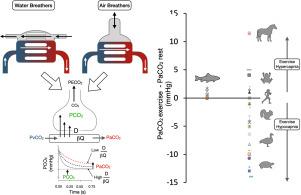Comparative Biochemistry and Physiology A: Molecular & Integrative Physiology ( IF 2.3 ) Pub Date : 2020-12-25 , DOI: 10.1016/j.cbpa.2020.110888 James W Hicks 1 , Tobias Wang 2

|
Elevations of metabolic rate, for example during physical activity, elicit immediate and coordinated respiratory and cardiovascular responses that ensure adequate diffusive and convective fluxes of O2 from the environment (water or air) to the mitochondria where ATP is produced. The same physiological responses also provide for CO2 to be removed in the opposite direction. There is significant variation in the morphology of the cardiovascular and respiratory structures among vertebrates, and a varying reliance on aerobic versus anaerobic metabolism to power activity. However, gas exchange in all vertebrates can be decribed as diffusive and convective steps in series, and we summarise data on the diffusive step across the respiratory surface of gills and lungs in this graphical review. Based on relatively constant arterial partial pressures of O2 and CO2 from rest to near maximal levels of physical activity, we conclude that under normoxic conditions, the diffusive step within the respiratory system exert no or small limitations for either O2 or CO2 exchange at or near maximal rate of oxygen consumption (VO2max). However, there are exceptions, such as the exercise-induced arterial hypoxemia (EIAH) in racehorses, and elite human athletes. Our analysis also indicates that exercise-induced arterial hypercapnia (i.e. a rise in arterial PCO2) at or near VO2max is not common among vertebrates. Across the vertebrate spectrum, the diffusive and perfusive conductances (D/βQ) of water and air-breathing vertebrates are well-matched to maximal rates of gas exchange, and diffusion is not a limiting factor when aerobic metabolism increases.
中文翻译:

最大代谢需求期间的动脉血气:脊椎动物谱系的模式
代谢率的升高,例如在体力活动期间,会引起立即和协调的呼吸和心血管反应,确保 O 2从环境(水或空气)到产生 ATP 的线粒体有足够的扩散和对流通量。相同的生理反应也提供 CO 2反方向拆除。脊椎动物的心血管和呼吸结构的形态存在显着差异,并且对有氧代谢与无氧代谢的依赖程度不同。然而,所有脊椎动物的气体交换都可以被描述为一系列的扩散和对流步骤,我们在这个图形审查中总结了穿过鳃和肺呼吸表面的扩散步骤的数据。基于从静止到接近最大体力活动水平的 O 2和 CO 2相对恒定的动脉分压,我们得出结论,在正常含氧条件下,呼吸系统内的扩散步骤对 O 2或 CO 2没有或只有很小的限制以或接近最大耗氧率(VO 2 max)进行交换。然而,也有例外,例如赛马和优秀人类运动员的运动引起的动脉低氧血症 (EIAH)。我们的分析还表明,运动引起的动脉高碳酸血症(即动脉 PCO 2升高)在或接近 VO 2 max 时在脊椎动物中并不常见。在整个脊椎动物谱中,水和呼吸空气的脊椎动物的扩散和灌注电导 (D/βQ) 与气体交换的最大速率非常匹配,当有氧代谢增加时,扩散不是限制因素。



























 京公网安备 11010802027423号
京公网安备 11010802027423号